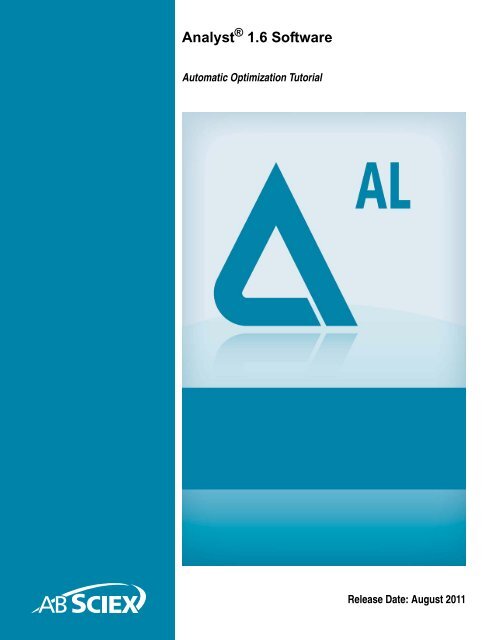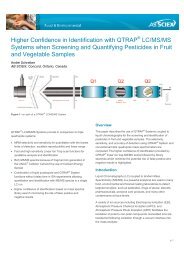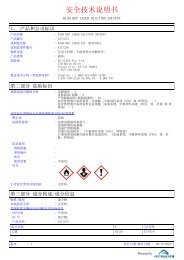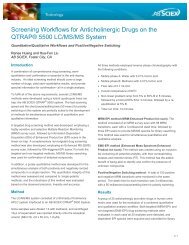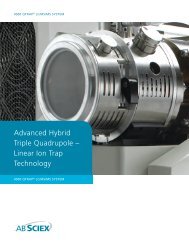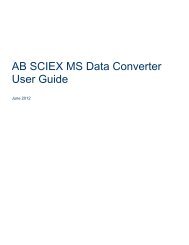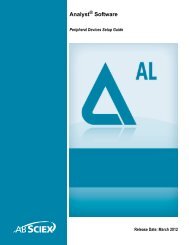Analyst® 1.6 Software Automatic Optimization Tutorial - AB Sciex
Analyst® 1.6 Software Automatic Optimization Tutorial - AB Sciex
Analyst® 1.6 Software Automatic Optimization Tutorial - AB Sciex
Create successful ePaper yourself
Turn your PDF publications into a flip-book with our unique Google optimized e-Paper software.
Analyst ® <strong>1.6</strong> <strong>Software</strong><br />
<strong>Automatic</strong> <strong>Optimization</strong> <strong>Tutorial</strong><br />
Release Date: August 2011
This document is provided to customers who have purchased<br />
<strong>AB</strong> SCIEX equipment to use in the operation of such <strong>AB</strong> SCIEX<br />
equipment. This document is copyright protected and any reproduction<br />
of this document or any part of this document is strictly prohibited,<br />
except as <strong>AB</strong> SCIEX may authorize in writing.<br />
<strong>Software</strong> that may be described in this document is furnished under a<br />
license agreement. It is against the law to copy, modify, or distribute<br />
the software on any medium, except as specifically allowed in the<br />
license agreement. Furthermore, the license agreement may prohibit<br />
the software from being disassembled, reverse engineered, or<br />
decompiled for any purpose.<br />
Portions of this document may make reference to other manufacturers<br />
and/or their products, which may contain parts whose names are<br />
registered as trademarks and/or function as trademarks of their<br />
respective owners. Any such usage is intended only to designate<br />
those manufacturers' products as supplied by <strong>AB</strong> SCIEX for<br />
incorporation into its equipment and does not imply any right and/or<br />
license to use or permit others to use such manufacturers' and/or their<br />
product names as trademarks.<br />
<strong>AB</strong> SCIEX makes no warranties or representations as to the fitness of<br />
this equipment for any particular purpose and assumes no<br />
responsibility or contingent liability, including indirect or consequential<br />
damages, for any use to which the purchaser may put the equipment<br />
described herein, or for any adverse circumstances arising therefrom.<br />
For research use only. Not for use in diagnostic procedures.<br />
The trademarks mentioned herein are the property of<br />
<strong>AB</strong> <strong>Sciex</strong> Pte. Ltd. or their respective owners.<br />
<strong>AB</strong> SCIEX is being used under license.<br />
<strong>AB</strong> SCIEX<br />
71 Four Valley Dr., Concord, Ontario, Canada. L4K 4V8.<br />
<strong>AB</strong> SCIEX LP is ISO 9001 registered.<br />
© 2011 <strong>AB</strong> SCIEX.<br />
Printed in Canada.
<strong>Automatic</strong> <strong>Optimization</strong> <strong>Tutorial</strong><br />
Topics in this tutorial:<br />
• Objectives on page 3<br />
• About <strong>Automatic</strong> <strong>Optimization</strong> on page 3<br />
• Related Documentation on page 4<br />
• Technical Support on page 4<br />
• Prerequisites on page 4<br />
• <strong>Automatic</strong>ally Optimizing for an Analyte Using Infusion on page 5<br />
• <strong>Automatic</strong>ally Optimizing for an Analyte using FIA on page 11<br />
Objectives<br />
You will learn how to:<br />
• <strong>Automatic</strong>ally optimize for the analyte using the Compound <strong>Optimization</strong> wizard.<br />
• Choose between infusion and FIA (flow injection analysis),<br />
• Use an infusion method to optimize compound-dependent parameters.<br />
• Use an FIA method to optimize compound- and ion source-dependent parameters.<br />
About <strong>Automatic</strong> <strong>Optimization</strong><br />
<strong>Automatic</strong> optimization first checks for the presence of the compounds. The voltages of the<br />
various ion path parameters are gradually increased or decreased to determine the maximum<br />
signal intensity (Q1 scan) for each ion. A text file is generated and displayed during the<br />
optimization process. This file records the various experiments performed and the optimal values<br />
for each parameter. A file folder containing all the experiments performed is also generated and<br />
can be found by opening the data file folder in Explore mode. For each experiment performed, an<br />
acquisition method is also generated and saved in the Acquisition Method folder.<br />
During the optimization process, you select how the precursor ion and the corresponding product<br />
ions are to be chosen.<br />
Types of Sample Introduction<br />
Infusion<br />
Infusion is the continuous flow of the sample at low flow rates into the ion source using a syringe<br />
pump. During the infusion optimization process, the software can select precursor and product<br />
ions and optimize for declustering potential, collision energy, and collision cell exit potential. The<br />
voltages of the ion path parameters are gradually increased or decreased to determine the<br />
maximum signal intensity for the precursor and product ions.<br />
Release Date: August 2011 3
<strong>Automatic</strong> <strong>Optimization</strong> <strong>Tutorial</strong><br />
Use infusion optimization to optimize compound-dependent parameters only at much lower flow<br />
rates than those used during LC/MS analysis.<br />
FIA<br />
FIA is the injection of a sample by the autosampler into the mass spectrometer using LC. During<br />
the FIA optimization process, multiple sample injections are performed for various ion source- or<br />
compound-dependent parameter types that are changed between injections. FIA compound<br />
optimization optimizes parameters by performing looped experiments in succession, that is, one<br />
compound- dependent parameter is optimized first followed by the next compound-dependent<br />
parameter. It optimizes for ion source-dependant parameters by making one injection for each<br />
value.<br />
Compound parameters need to be narrowed down using at least two more FIA cycles. Use FIA<br />
optimization to optimize both compound-dependent and source-dependent parameters using LC<br />
at higher flow rates.<br />
Table 1-1 Differences Between Sample Introduction Methods<br />
Method Required devices Parameters Typical flow rate range<br />
Infusion Syringe pump Compound-dependent 5 to 25 µL/min<br />
FIA LC pump and<br />
Autosampler<br />
Source- and compounddependent<br />
25 to 1000 µL/min<br />
During optimization, a text file is generated and then displayed during the optimization process.<br />
This file records the various experiments performed and the optimal values for each parameter. A<br />
file folder containing all the data files is also generated. For each experiment performed, an<br />
acquisition method is also generated and saved in the Acquisition Methods folder.<br />
Related Documentation<br />
• Getting Started Guide for the Analyst ® software<br />
• <strong>Software</strong> Reference Guide for the Analyst software<br />
• The Analyst software Help system<br />
• The applicable ion source guide<br />
Technical Support<br />
<strong>AB</strong> SCIEX and its representatives maintain a staff of fully-trained service and technical<br />
specialists located throughout the world. They can answer questions about the instrument or any<br />
technical issues that may arise. For more information, visit the Web site at www.absciex.com.<br />
Prerequisites<br />
• The instrument is tuned and calibrated.<br />
• An acquisition method.<br />
4 Release Date: August 2011
<strong>Automatic</strong> <strong>Optimization</strong> <strong>Tutorial</strong><br />
• If the system has an integrated syringe pump, there is a hardware profile containing<br />
a syringe pump.<br />
• For sample introduction by FIA, the hardware profile must contain an LC pump and<br />
an autosampler.<br />
• All the required peripheral devices, including a syringe pump, if needed, and LC<br />
components.<br />
The following equipment and solutions are suggested. You can use other solutions depending on<br />
your system, peripheral devices, and experiment.<br />
• A syringe, preferably a 1.0 ml. syringe.<br />
• Mobile phase: 1:1 acetonitrile:water + 2 mM ammonium acetate + 0.1% formic acid.<br />
• LC pump and autosampler.<br />
• Autosampler vials.<br />
• 4-compound mix, consisting of reserpine, minoxidil, tolbutamide, and rescinnamine.<br />
The solution can be used for infusion and FIA. The concentration is systemdependent.<br />
Use a solution that is 49.9% acetonitrile, with /50% deionized water and<br />
0.1% formic acid as diluent.<br />
Table 1-2 Compounds and Molecular Weights<br />
Compound<br />
m/z<br />
Minoxidil 210.2<br />
Tolbutamide 271.3<br />
Reserpine 609.4<br />
Rescinnamine 635.4<br />
Table 1-3 Estimates For Starting Concentrations<br />
System<br />
API 2000 and QTRAP ® systems<br />
API 3200 and 3200 QTRAP systems<br />
API 4000 and 4000 QTRAP systems<br />
API 5000 system<br />
<strong>AB</strong> SCIEX QTRAP 5500 system<br />
<strong>AB</strong> SCIEX Triple Quad 5500 system<br />
Concentration<br />
500 ng/mL<br />
50 ng/mL<br />
10 ng/mL<br />
10 ng/mL<br />
10 ng/mL<br />
10 ng/mL<br />
<strong>Automatic</strong>ally Optimizing for an Analyte Using<br />
Infusion<br />
In this section, you will learn how to perform automatic MS/MS optimization using infusion with a<br />
known precursor ion and an unknown product ion.<br />
Topics in this section:<br />
• Confirming the Presence of Compounds on page 6<br />
Release Date: August 2011 5
<strong>Automatic</strong> <strong>Optimization</strong> <strong>Tutorial</strong><br />
• Compound ions on page 7<br />
• Checking the <strong>Optimization</strong> Results on page 10<br />
Confirming the Presence of Compounds<br />
You should confirm the presence of compounds of interest before continuing with automatic<br />
optimization.<br />
1. Create a project.<br />
2. Activate the hardware profile.<br />
3. Infuse the compound in solution at a rate of 5 to 10 µL/min.<br />
4. On the Navigation bar, under Tune and Calibrate, double-click Manual Tuning.<br />
5. If your instrument has an integrated syringe pump, in the method list field, click<br />
Syringe Pump Method.<br />
6. On the Syringe Pump Method Properties tab, type the parameters from the<br />
following table.<br />
Table 1-4 Syringe Pump Method Properties Tab<br />
Parameter<br />
Value<br />
Syringe Diameter<br />
Syringe dependent. 1.0 ml syringe is 4.610 mm<br />
Flow Rate 10<br />
Unit<br />
µL/min<br />
Figure 1-1 Syringe Pump Method Properties tab<br />
7. Click Start Syringe Pump.<br />
8. In the method list field, click MS Method.<br />
9. On the MS tab, type the parameters from the following table.<br />
Table 1-5 MS Tab<br />
Parameter<br />
Value<br />
Scan type<br />
Q1 MS (Q1)<br />
Start (Da) 200<br />
Stop (Da) 700<br />
* These fields are instrument-dependent.<br />
6 Release Date: August 2011
<strong>Automatic</strong> <strong>Optimization</strong> <strong>Tutorial</strong><br />
Table 1-5 MS Tab (Continued)<br />
Parameter<br />
Value<br />
*Time (sec) (if available) 2.5<br />
*Scan rate (Da/s) (if available) 200<br />
Duration (min) 3<br />
* These fields are instrument-dependent.<br />
10. Click Start.<br />
11. Wait until you see an even TIC on the left and peaks on the right and then click Stop.<br />
12. Select the MCA check box and then, in the Cycles field, type 10.<br />
13. Click Start.<br />
14. When the ten scans are complete, you should see the masses of the four<br />
compounds as ions.<br />
Note: The intensities of the compounds should be much higher than the<br />
smallest noise peaks but not so high that you can not see any noise peaks. In<br />
the first case, you may not be looking at a real compound. In the second<br />
case, you may have too high a concentration for the software to optimize<br />
properly.<br />
Figure 1-2 Compound ions<br />
Release Date: August 2011 7
<strong>Automatic</strong> <strong>Optimization</strong> <strong>Tutorial</strong><br />
Performing <strong>Automatic</strong> MS and MS/MS <strong>Optimization</strong> using<br />
Infusion with a Known Precursor Ion and an Unknown<br />
Product Ion<br />
<strong>Automatic</strong> optimization for MS/MS analysis optimizes certain compound-dependent parameters<br />
for one or more MRM transitions.The software finds the ion of interest and optimizes the<br />
compound-dependent parameters to get the maximum sensitivity for the compound. The<br />
software ramps CE and picks the most intense fragments meeting all the product ion selection<br />
criteria.<br />
If the Initial Q1 scan signal is too high, the Analyst ® software attempts to lower the CEM to keep<br />
ions within detector range. If the signal is still too high after lowering the CEM, the process stops<br />
and an error message is displayed. You must dilute the solution and then restart the optimization.<br />
Be sure to purge the infusion line. The parameters from the last quantitative optimization are<br />
stored.<br />
1. On the Navigation bar, under Tune and Calibrate, double-click Compound<br />
<strong>Optimization</strong>.<br />
2. On the Instrument Settings page, in the Inlet section, click Infusion.<br />
3. In the Mass Spectrometer section, click MS/MS Analysis and then click Next.<br />
4. On the Ions to use in MS/MS Analysis page, type the parameters from the<br />
following table.<br />
Table 1-6 MS/MS Analysis Page<br />
Parameter<br />
Value<br />
MW Ion: Search Window 2.500<br />
Resolution<br />
Unit<br />
Polarity<br />
Positive<br />
Product Ion<br />
Auto Select<br />
Resolution<br />
Unit<br />
Note: The optimization algorithm looks for the most intense peak in the<br />
search window that you specified. If the most intense peak in that window is<br />
not the mass of interest, the software will optimize on the wrong ion.<br />
5. Click Criteria next to the Auto Select option.<br />
6. In the Product Ion Auto Selection Criteria dialog, type the parameters from the<br />
following table.<br />
8 Release Date: August 2011
<strong>Automatic</strong> <strong>Optimization</strong> <strong>Tutorial</strong><br />
Table 1-7 Product Ion Auto Selection Criteria Dialog Parameters<br />
Parameter Value Description<br />
From the Most<br />
Intense (peaks)<br />
Build final method<br />
using (most intense<br />
peaks)<br />
Exclude Product<br />
Ions within ± (Da of<br />
Precursor Ion m/z)<br />
Min. Mass for<br />
Product Ion (amu)<br />
Threshold for<br />
Product Ion (cps)<br />
3 The number of fragment peaks to be optimized.<br />
The algorithm will generate a product ion scan<br />
spectrum while ramping the CE in MCA mode. In<br />
this example, it will then take the 3 most intense<br />
fragment ions from the spectrum and continue<br />
the MS/MS optimization on those fragments only.<br />
2 The number of fragment ions per precursor ion<br />
(target compound) to be automatically included in<br />
the acquisition method. The specified number<br />
defines the number of MRM transitions to be<br />
included for each target compound in the<br />
method, and the order of preference is based on<br />
the intensity of the fragment ion.<br />
Two is a better starting value than one because<br />
you will typically want two product ions for<br />
quantitation. You can start with three in case<br />
there is a problem with one of the two best; you<br />
can go back and the third is already identified.<br />
20.000 The Da value that defines the exclusion window<br />
around the precursor ion so that fragment ions<br />
that fall within this window are not selected for<br />
MRM optimization. For example, if you type ± 5<br />
Da for a precursor ion of 500 m/z, any fragment<br />
ions within the 495 to 505 m/z region are<br />
excluded. This prevents the precursor ion from<br />
being optimized.<br />
60.000 The lowest fragment mass to be considered for<br />
optimization. Use this option to narrow or widen<br />
the window of fragment ions to be considered<br />
from the precursor mass.<br />
100.000 Minimum number of counts for a product ion to<br />
be considered.<br />
7. Click OK to save the changes to the selection criteria.<br />
8. Click Next.<br />
9. In the Target Components dialog, type the parameters from the following table.<br />
Note: The compound name must be unique for each compound or<br />
transition.<br />
Release Date: August 2011 9
<strong>Automatic</strong> <strong>Optimization</strong> <strong>Tutorial</strong><br />
Table 1-8 Target Compounds Dialog Parameters<br />
Target Compound Field Value*<br />
Reserpine Compound Name Reserpine<br />
MW (Da) 609.4<br />
No. Charges 1<br />
Minoxidil Compound Name Minoxidil<br />
MW (Da) 210.2<br />
No. Charges 1<br />
Tolbutamide Compound Name Tolbutamide<br />
MW (Da) 271.3<br />
No. Charges 1<br />
Rescinnamine (IS) Compound Name Rescinnamine<br />
MW (Da) 635.4<br />
No. Charges 1<br />
* You must type the exact ion mass.<br />
10. Click Finish to begin the optimization process.<br />
The screen displays two windows, a text file window and an acquisition window. You<br />
may need to minimize one of them to see the other. The experiment being run is<br />
displayed on the top of the acquisition window. The x-axis shows the parameter that<br />
is being optimized for each experiment. The text file window is updated as results<br />
are generated.<br />
After optimization is complete, an MRM acquisition file is created and named<br />
[compound]_QOpt_FinalMRM_Pos.dam, where [compound] is the first compound in<br />
the Target Components page.<br />
Checking the <strong>Optimization</strong> Results<br />
At the end of the optimization, the optimized parameters are saved in an acquisition method. All<br />
.dam and .wiff files generated in the optimization process are saved in the Acquisition Method<br />
folder and in a subfolder in the Data folder respectively in the project. The name of the subfolder<br />
is generated using the name of the compound and the date.<br />
1. After completing the optimization, print the text file containing the optimized<br />
parameters for each compound.<br />
2. Click File > Open and select the Reserpine_QOpt_FinalMRM.POS.dam file you just<br />
created.<br />
3. Compare the values in the text file to those in the .dam file.<br />
10 Release Date: August 2011
<strong>Automatic</strong> <strong>Optimization</strong> <strong>Tutorial</strong><br />
4. Check the contents of the following folders:<br />
• Data: Look through all the runs executed during optimization. Compare a .wiff<br />
file with the optimized value in the method or printed parameters.<br />
• Acquisition Method: Reserpine_QOpt_FinalMRM.POS.dam file and other<br />
.dam files created during optimization.<br />
• Log: Report file (.rtf) displayed during the optimization process.<br />
<strong>Automatic</strong>ally Optimizing for an Analyte using<br />
FIA<br />
Before you optimize using FIA, you should already have identified the ions for the compounds<br />
and saved the basic acquisition method using the infusion method used earlier in this tutorial.<br />
Because using FIA for optimization requires that an autosampler and LC pump be active in the<br />
hardware profile, you must add these two devices to the basic acquisition method.<br />
Note: Although you can use FIA to optimize compound-dependent parameters, this is<br />
typically not done because of the number of cycles required to obtain the optimal<br />
parameter values.<br />
Before you begin, make sure that you create an LC/MS/MS acquisition method based on the<br />
Reserpine_QOpt_FinalMRM.POS.dam file and name the new method<br />
FIA_AutoOpt_<strong>Tutorial</strong>.dam. Make sure that you are in the project that contains the acquisition<br />
method that you are going to work with.<br />
1. Put a dilution of 4-compound mix in an autosampler.<br />
You need enough sample to look at each variable of each parameter and have<br />
sample left over. For example, for temperature, if you want to run at 300, 400, and<br />
500°C you need more then 30 µL (3 × 10 µL injection).<br />
2. Confirm that LC Sync is selected in the method.<br />
Figure 1-3 Acquisition method with LC Sync selected<br />
3. Make sure you have reasonable starting ion source and gas parameters so you do<br />
not contaminate the instrument while optimizing. For more information, see the<br />
appropriate ion source operator’s guide.<br />
Release Date: August 2011 11
<strong>Automatic</strong> <strong>Optimization</strong> <strong>Tutorial</strong><br />
4. Set the horizontal micrometer to 5 mm. Set the vertical micrometer on the ion source<br />
for your flow rate. For the Turbo V ion source use the following parameters as a<br />
starting point. For more information, see the Turbo V Ion Source Operator’s Guide.<br />
Table 1-9 Turbo V Ion Source Vertical Parameters<br />
Flow rate<br />
Initial vertical parameters<br />
1 to 20 µL/min 10 mm<br />
20 to 250 µL/min 5 mm<br />
250 to 500 µL/min 2 mm<br />
500 + µL/min 0 mm<br />
5. Set the values for your LC system and use an autosampler injection volume of 10<br />
µL. Use the same concentration or lower as for the infusion experiment.<br />
The LC pumps must be set for an isocratic run with no column. The MS and LC<br />
times must be the same to collect the proper data.<br />
The flow rate and percent of mobile phases used should be based on the LC column<br />
used, the general chromatography, and the approximate mobile phase concentration<br />
at which your compounds of interest elute.<br />
6. On the Navigation bar, under Tune and Calibrate, double-click Compound<br />
<strong>Optimization</strong>.<br />
7. On the Instrument Settings page, depending on the stack you are using, type the<br />
parameters from the following table.<br />
Table 1-10 Instrument Settings Parameters<br />
Parameter Value<br />
Inlet<br />
FIA<br />
Default Acq. Method FIA_AutoOpt_<strong>Tutorial</strong>.dam<br />
Rack Code<br />
Autosampler specific<br />
Rack Position Autosampler specific<br />
Injection Volume 10 µL<br />
Mass Spectrometer MS/MS Analysis<br />
8. Click Next.<br />
9. On the FIA Target Compounds page, do not select the Int. Std. check box.<br />
Selecting the check box indicates which MRM corresponds to the internal standards.<br />
Internal standards are not optimized during the optimization process.<br />
10. In the Resolution section, select Unit in both the Q1 Resolution and Q3 Resolution<br />
fields.<br />
12 Release Date: August 2011
<strong>Automatic</strong> <strong>Optimization</strong> <strong>Tutorial</strong><br />
Figure 1-4 Q1 and Q3 Resolution fields<br />
11. Click Next.<br />
12. On the FIA Source Parameters page, type numbers that are lower or higher than<br />
the original value as long as they are still within specifications. Be sure not to go too<br />
low with any of the settings to keep your system clean. The following parameters<br />
should work for most flow rates.<br />
Table 1-11 Parameters for FIA Source Parameters Page<br />
Parameter<br />
Select the Optimize<br />
check box?<br />
Values for<br />
optimization<br />
Curtain Gas Yes 20;40;55<br />
Collision Gas No —<br />
IonSpray Voltage Yes 1500;2000;3000;4000;500<br />
0<br />
Temperature Yes 300;400;500;600;700<br />
Ion Source Gas 1 Yes 40;50;60;70;80;90<br />
Ion Source Gas 2 Yes 40;50;60;70;80;90<br />
Interface Heater No —<br />
13. Select 1 or 2 beside Replicate Injection for each Parameter.<br />
The total number of injections and the total sample volume are calculated based on<br />
the specifications here. Note the total sample volume needed. Sample volume may<br />
be high depending on how many variables for each parameter you are optimizing, as<br />
each variable is a separate method.<br />
Release Date: August 2011 13
<strong>Automatic</strong> <strong>Optimization</strong> <strong>Tutorial</strong><br />
Figure 1-5 Replicate Injection for each Parameter field<br />
14. Click Next.<br />
15. On the FIA Compound Parameters page, type the parameters from the following<br />
table.<br />
Note: The values in Table 1-12 are suggested values. For more<br />
information, see the documentation or Help.<br />
Table 1-12 FIA Compound Parameters Page<br />
Parameter<br />
Select the Optimize<br />
check box?<br />
Values for<br />
optimization<br />
Declustering Potential Yes 60;80;100;120;200<br />
Entrance Potential No —<br />
Collision Energy Yes 20;30;40;50;70;80;100<br />
Collision Cell Exit<br />
Potential<br />
Yes 2;4;6;8;10;12<br />
The total number of injections and dependent sample volume update automatically.<br />
In contrast to ion source parameters, which require one injection per value per<br />
replicate, compound-dependent parameters only require one injection per<br />
parameter. A looped experiment is performed for each parameter; the values are<br />
alternated scan by scan within one injection.<br />
Note: Do not enter too many values that will prevent proper evaluation of<br />
the parameter.<br />
14 Release Date: August 2011
<strong>Automatic</strong> <strong>Optimization</strong> <strong>Tutorial</strong><br />
16. In the Mass Spec. Duration field, type 1.5. This value should be at least the<br />
required length of time for each injection.<br />
Figure 1-6 Mass Spec. Duration field<br />
17. Click Finish to begin the optimization process.<br />
The software optimizes the specified ion source- and compound-dependent<br />
parameters to get the maximum sensitivity for the MRM transition of the compound.<br />
As the software proceeds through the optimization, it creates a Compound<br />
<strong>Optimization</strong> report.<br />
To obtain optimized parameters, this routine must be repeated. Typically, the ion<br />
source and gas parameters must be narrowed using one more FIA cycle.<br />
18. The software generates several acquisition methods. Open the final optimized FIA<br />
method called *_FIA_sample_1. Save this method using a simpler name.<br />
Release Date: August 2011 15
<strong>Automatic</strong> <strong>Optimization</strong> <strong>Tutorial</strong><br />
16 Release Date: August 2011


